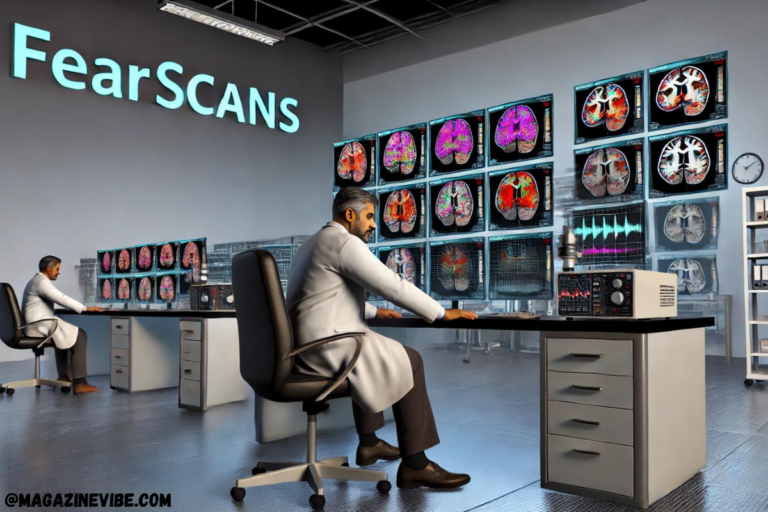Introduction to Fearscans
Fearscans could mean different things depending on context. If we think of it as a term or technology, it might refer to a method for studying or measuring fear in individuals. This could involve technology that scans brain activity or physiological responses when a person experiences fear.
This concept might be relevant in fields like psychology, where understanding fear is crucial for treating phobias or anxiety disorders. It could also apply in safety training or entertainment, where knowing how people react to fear can help create more effective or thrilling experiences.
The Science Behind Fearscans
Fearscans could be based on scientific principles related to how the brain and body respond to fear. When a person feels fear, their body reacts in certain ways. These reactions might include increased heart rate, rapid breathing, and changes in brain activity. Fearscans may involve technologies like brain imaging or sensors that detect these physical changes.
If fearscans are a technology, they might work by scanning brain waves or tracking heart rate and breathing patterns. This could help researchers or doctors understand how fear affects the body and brain in real-time. If fearscans are more of a psychological concept, they could involve studying how fear impacts a person’s thoughts and actions. Either way, the idea is to measure and analyze fear in a clear, scientific manner.
Applications of Fearscans
Fearscans can be useful in several industries. In healthcare, they could help doctors understand how patients respond to fear during medical procedures. This could improve treatments for anxiety disorders or phobias. In psychology, therapists might use fearscans to study a person’s fear triggers and develop better therapies for managing those fears.
In entertainment, such as video games or movies, fearscans could help creators design more engaging experiences by understanding what makes audiences feel scared. Fearscans could also be useful in safety training, like for firefighters or soldiers, to help them handle fear in high-pressure situations.
The benefits of fearscans in professional settings include improved understanding of fear responses, better treatments for anxiety, and creating more effective training or entertainment experiences. These applications could lead to better outcomes for both professionals and the people they serve.
Case Studies or Examples
There are several potential scenarios where fearscans could be applied. In psychology, a real-life example might involve patients with phobias. A therapist could use fearscans to measure a patient’s fear levels during exposure therapy. By tracking the patient’s reactions, the therapist can adjust the treatment to help reduce the fear response over time.
In entertainment, a hypothetical scenario could involve a virtual reality game where fearscans are used to measure players’ fear levels. The game could adapt in real-time, becoming more or less intense based on the player’s fear, creating a highly personalized experience.
A research success story might involve a study that used fearscans to track how soldiers respond to fear in combat training. The findings could help improve training methods by teaching soldiers how to better manage fear in high-stress situations. These examples show how fearscans can be applied in different fields to enhance results and experiences.
Comparative Analysis
Fearscans can be compared to other technologies or methods used to measure fear, such as heart rate monitors or brain imaging techniques like fMRI. While these traditional methods track physical signs of fear, fearscans could provide more detailed, real-time insights by combining multiple measurements, such as brain activity and physiological responses, in a single scan.
One advantage of fearscans is their potential for greater accuracy. They may offer a more complete picture of how a person experiences fear by capturing both mental and physical reactions. In contrast, traditional methods often focus on one aspect, like heart rate, which may not always fully represent the level of fear.
However, fearscans might have limitations. They could require more advanced technology and training to use, making them more costly or less accessible. Traditional methods like heart rate monitors are simpler and more widely available. Despite these challenges, fearscans could provide richer data, making them valuable for research and practical applications where deeper fear analysis is needed.
Challenges and Ethical Considerations
The development and implementation of fearscans face several challenges. One major challenge is the accuracy of the technology. Measuring fear involves capturing complex reactions in the brain and body, and not all fear responses are the same for everyone. Ensuring that fearscans can accurately detect and interpret these responses for different individuals is a significant hurdle. Another challenge is the cost and accessibility of the technology. Advanced equipment may be expensive, limiting its use in smaller clinics or industries.
Ethically, the use of fearscans raises important concerns. One key issue is privacy. Fear is a deeply personal emotion, and scanning someone’s fear response without consent could lead to serious privacy violations. There is also the potential for misuse, such as using fearscans in marketing to manipulate emotions or in law enforcement in ways that could invade individual rights.
The societal impact of fearscans could be both positive and negative. While they may improve mental health treatments and create better experiences in various fields, there is a risk of creating a world where emotions like fear are monitored and controlled in ways that limit personal freedom. These ethical considerations must be carefully addressed as fearscans are developed and used.
Future of Fearscans
The future of fearscans holds exciting possibilities as technology continues to advance. We can predict that fearscans will become more accurate and accessible with the development of better sensors and data analysis tools. As more industries recognize the potential of understanding human fear, we may see fearscans being used widely in healthcare, virtual reality, entertainment, and training programs.
In the future, fearscans might also be integrated with artificial intelligence (AI), allowing the technology to not only detect fear but also adapt and respond in real-time. For instance, in virtual reality gaming, AI-powered fearscans could adjust the game’s difficulty based on the player’s fear levels, creating a personalized experience. In healthcare, AI could analyze the data from fearscans to create more effective treatments for anxiety and phobias.
Emerging markets like mental health treatment, military training, and emergency response could significantly benefit from fearscans. These fields require a deep understanding of fear and stress responses, making fearscans a valuable tool for improving performance, training, and overall well-being. The future for fearscans is likely to see widespread adoption across these and other fields as the technology evolves.
How to Access or Utilize Fearscans
For individuals or organizations looking to start using fearscans, the first step is to determine the purpose. Whether it’s for research, therapy, or enhancing user experiences, knowing the goal will help in choosing the right technology or method. Fearscans may require specialized equipment, such as brain imaging devices, heart rate monitors, or advanced biofeedback systems that track physiological responses.
To access fearscans, partnering with technology providers or research institutions that offer such services might be necessary. Organizations interested in implementing fearscans for healthcare, entertainment, or training could consult tech firms that specialize in biometric monitoring or psychological assessment tools.
For further learning and exploration, individuals can explore online courses on neuroscience and psychophysiology to understand how fear is measured scientifically. Research articles and publications on emotional biometrics and fear detection can also provide insights into how fearscans work. Conferences and workshops in fields like neurotechnology and mental health tech can also be valuable resources for those interested in utilizing fearscans.
Conclusion
In summary, fearscans represent a promising approach to understanding and measuring fear in both scientific and practical ways. From healthcare to entertainment, fearscans have the potential to revolutionize how we detect and manage fear, offering more personalized treatments, enhancing user experiences, and improving training programs in high-stress environments.
The technology behind fearscans could transform fields like mental health, virtual reality, and emergency response by providing real-time insights into fear responses. However, challenges such as accuracy, cost, and ethical concerns must be carefully considered as the technology evolves. As fearscans become more advanced and accessible, their impact on various industries is likely to grow, opening new doors for innovation and better understanding of human emotions.
FAQs
Q. What are fearscans?
Fearscans refer to technologies or methods used to measure fear responses in individuals by tracking physical and psychological reactions, such as brain activity, heart rate, and breathing patterns.
Q. How do fearscans work?
Fearscans use sensors or brain imaging tools to monitor changes in the body and mind when someone experiences fear. These tools track physical signs like increased heart rate or brainwave patterns associated with fear.
Q. In which industries are fearscans used?
Fearscans can be applied in various industries such as healthcare for treating anxiety, entertainment to create personalized experiences, and military or emergency training to help individuals manage fear under pressure.
Q. What are the benefits of using fearscans?
The benefits include better understanding of fear responses, more effective treatments for anxiety disorders, improved safety training, and enhanced user experiences in entertainment.
Q. What are the challenges with fearscans?
Challenges include ensuring accuracy, the high cost of advanced equipment, and ethical concerns related to privacy and potential misuse of fear data.
Q. How could fearscans impact the future?
In the future, fearscans may become more accurate and widely used across industries. They could help professionals in fields like healthcare, virtual reality, and training to create better solutions for managing fear.
Q. Are there ethical concerns with fearscans?
Yes, fearscans raise ethical concerns related to privacy, as they involve tracking personal emotional responses. There is also a risk of misuse in fields like marketing or surveillance.
Q. Can fearscans be used for therapy?
Yes, fearscans can help therapists better understand a patient’s fear responses and develop personalized treatments for phobias, anxiety, and other fear-related issues.
Q. How can someone start using fearscans?
Individuals or organizations interested in using fearscans should consult with technology providers or research institutions that offer biometric monitoring tools. They can also explore online courses and resources on neuroscience and psychophysiology to learn more.
Q. What is the future potential of fearscans?
Fearscans have the potential to transform fields such as mental health, military training, and entertainment by providing real-time insights into human fear, leading to more personalized and effective experiences.


